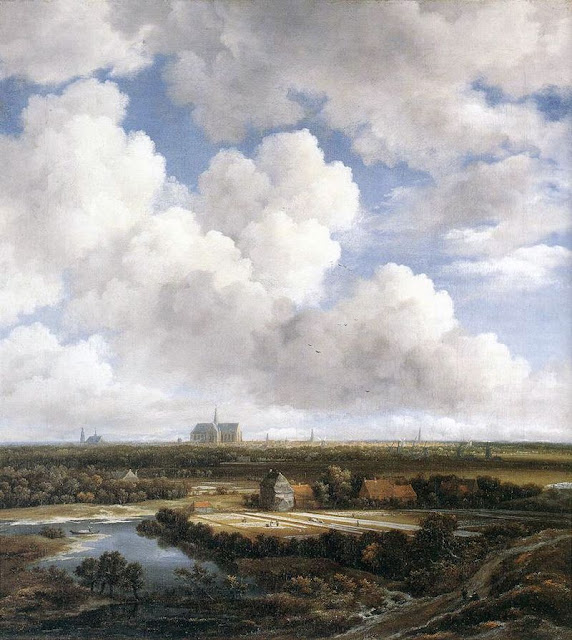In short, my work is about the suggestion of spatiality that I want to render as clearly as possible with paint on a canvas. With difficulty, I made a selection of very diverse greats including musicians and composers in both classical, jazz and pop fields. In this blog, I have limited myself to three visual artists from art history.
Jacob van Ruysdael
View of Haarlem with bleaching fields
1670-1675
oil on canvas
62,2 × 55,2 cm
Annemieke Alberts
True colours
2022
acrylic and oil on canvas
100 x 120 cm
There are paintings that are ingrained in the collective memory of most art lovers and artists. You know them so well that you don’t actually look closely anymore. But then suddenly you can see a work from a different perspective. For example, when you are looking for solutions to a substantive problem with a new work. At that time, I was searching for another way to give form to spatiality.
This is how I rediscovered the work of Jacob van Ruysdael: 'Gezicht op Haarlem met bleekvelden'. It was on the cover of an artbook. Suddenly I saw it with different eyes. The way in which he emphasizes the vastness of the landscape in the painting and takes you as a viewer via the bleaching fields to the horizon is obvious but surprising at the same time. They lie like illuminated refuge hills inviting you to rest for a moment before you move on to what is to be experienced in the distance.
It inspires me how you can see that feature almost as an abstract form within an otherwise figurative and realistic painting. It has encouraged me to make use of similar forms in my work. Shapes that in another context could be seen as abstractly geometric but now can act as a resting point between everything that is happening in and with the paint concerning layering, handwriting, movement. Independent of any representation. It has also encouraged me not to distinguish between abstract or figuration.
What also struck me was the beauty of silence in the work. Something I am always looking for in my work as well. Beauty that touches you, something that transcends opinions about what art should be.
Francis Bacon
In memory of George Dyer
1971
oil on canvas
each panel 198 x 147,5 cm
Francis Bacon
Man in Blue
1954
oil on canvas
197 x 135 cm
Annemieke Alberts
The view
2013
acrylic and oil on canvas
120 x 150 cm
Someone who applied this fact frequently in his somewhat later work is Francis Bacon. If you were to leave aside the fact that his work is precisely about people, but look purely at how he renders his figures (forms) with a firm stroke, and where paint is allowed to be matter, and in addition places densely painted abstract forms to indicate space, then there is also (in addition to the interesting subjects) on the formal plane much to experience. What touches me in his work is the inability of his portrayed figures to relate to their surroundings. The inner struggle has turned inside out in my experience.
Piranesi
Untitled (called The Drawbridge)
plate VII (of 16) from the series The Imaginary Prisons (Le Carceri d'Invenzione)
1761
etching with engraving
54,6 x 41,6 cm
Annemieke Alberts
U.S.O. unidentified standing objects
2017
acrylic and oil on canvas
160 x 180 cm
In Piranesi’s work I recognize the fascination with complex and layered spaces. Spaces that evoke confusion because they give the impression of being impossible in reality. With the difference that Piranesi’s work is graphic and composed of lines. I also often paint away complex pieces that are still visible under the top layer, and his work is much more detailed than mine.
In this painting (U.S.O), previously painted spaces under the top layer are still more or less visible.
Annemieke Alberts, 2022




%20ok.jpg)






